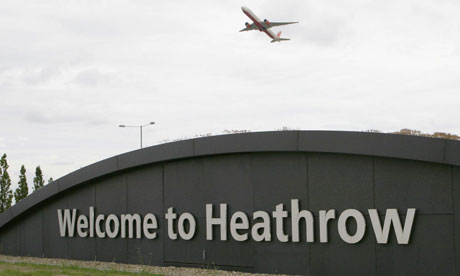The new report, entitled “Best placed for Britain”, says that expanding Heathrow is the quickest way for Britain to get ahead in the global race, connecting the UK to growing markets around the world faster and at less cost to the taxpayer than any other hub option. The report has been compiled by Heathrow Airport with architectural and planning consultants AECOM and Quod, and was commissioned as part of new evidence to present to the Airports Commission under Sir Howard Davies.
The report shows that compared to a new hub Heathrow is:
Best for passengers. Building a new hub airport to the east of London would increase travel times for 90% of hub passengers. Even if a new hub airport came with a major investment in new transport infrastructure, Heathrow would still have 4 million more people within 60 minutes travel time. The economic cost of longer journeys to a new hub could be £26bn net present value – the equivalent to cancelling out all the benefits of reduced journey time delivered by High Speed 2.
Best for business and the economy. The area around Heathrow is home to some of the world’s most highly productive business clusters in industries like IT and pharmaceuticals. In total 202 of the UK’s top 300 company HQs are in close proximity to Heathrow. The area has 60% more international businesses, twice as many US businesses, and three and a half times as many Japanese businesses than the national average.
Best for local jobs. The 76,600 people directly employed at Heathrow would face re-location or redundancy if Heathrow was replaced by a new airport. Direct job losses would be far greater than those that occurred when the largest single redundancy in the UK took place at Shotton Steel in 1985 and MG Rover closed its factory at Longbridge in 2005 (both 6,500 jobs), or the worst year of pit closures in the UK, 1984 (30,000 jobs).
Best for speed of delivery. Additional capacity at Heathrow could be delivered around 7 years more quickly than any new hub airport could be built. Any delay is critical, as the UK is losing some £14bn a year in trade and export earnings due to constraints in aviation hub capacity. Each additional year of delay would see the UK fall further behind European hub competitors in the global race for growth and jobs.
Best for taxpayers. Adding capacity at Heathrow will cost the taxpayer much less than building a new hub airport. The report calculates for the first time that £20-£25bn of sunk rail infrastructure cost has been committed around Heathrow since the 1970s. Any new hub would need to build vast new infrastructure from scratch using public money. Mayor of London Boris Johnson estimates that a new hub airport would cost in the region of £70-80 billion of which £25 billion would require public subsidy.
Colin Matthews, CEO of Heathrow, said:
“Britain already has one of the world’s most successful international hub airports in Heathrow. Expanding Heathrow will put Britain ahead in the global race, connecting UK business to growth more quickly and at less cost to the taxpayer than any other option for new capacity. Heathrow is better located for passengers, business and jobs. Why build from scratch at a new hub when we can build on the strength that already exists around Heathrow today?”
Ends
Notes to editors:
The full report “Best placed for Britain” is available online at:http://mediacentre.heathrowairport.com/ImageLibrary/downloadmedia.ashx?MediaDetailsID=1507&SizeId=-1
The UK Government set up the Airports Commission in 2012 to examine the need for additional UK airport capacity. The Commission is responsible for submitting an interim report to the government by the end of 2013 identifying and recommending options for maintaining the UK’s status as an international hub for aviation. It will submit its final recommendations to government by summer 2015.
Capacity is constrained at the UK’s only global hub, Heathrow, which has been virtually full since 2003. Heathrow provides long haul services to direct and transferring passengers. Other UK airports such as Gatwick, Manchester and Birmingham operate a ‘point-to-point’ model, providing a wide range of direct short-haul flights but few long-haul services.
Heathrow and the Mayor of London both agree that the UK needs additional capacity at a single major hub airport with the size and scale to compete with other international hub airports such as Frankfurt, Paris and Amsterdam. We only disagree on the question of where this additional capacity should be added – at Heathrow or at a new hub airport to the east of London.
Today’s report does not cover the environmental and sustainability issues associated with building additional runway capacity. We recently published a separate document, ‘A Quieter Heathrow’, outlining Heathrow’s approach to noise mitigation which is available here:
http://mediacentre.heathrowairport.com/ImageLibrary/downloadmedia.ashx?MediaDetailsID=1474&SizeId=-1
In July, we will submit options to the Airports Commission for additional runway capacity at Heathrow and set out environmental impacts.
Gatwick has not been included in the report as a potential location for the UK’s hub because it is only proposing a two-runway solution and therefore could not be any larger than Heathrow is today.
http://mediacentre.heathrowairport.com/Press-releases/New-research-shows-replacing-Heathrow-with-a-new-hub-airport-would-leave-passengers-taxpayers-and-594.aspx
The report is at:
.

